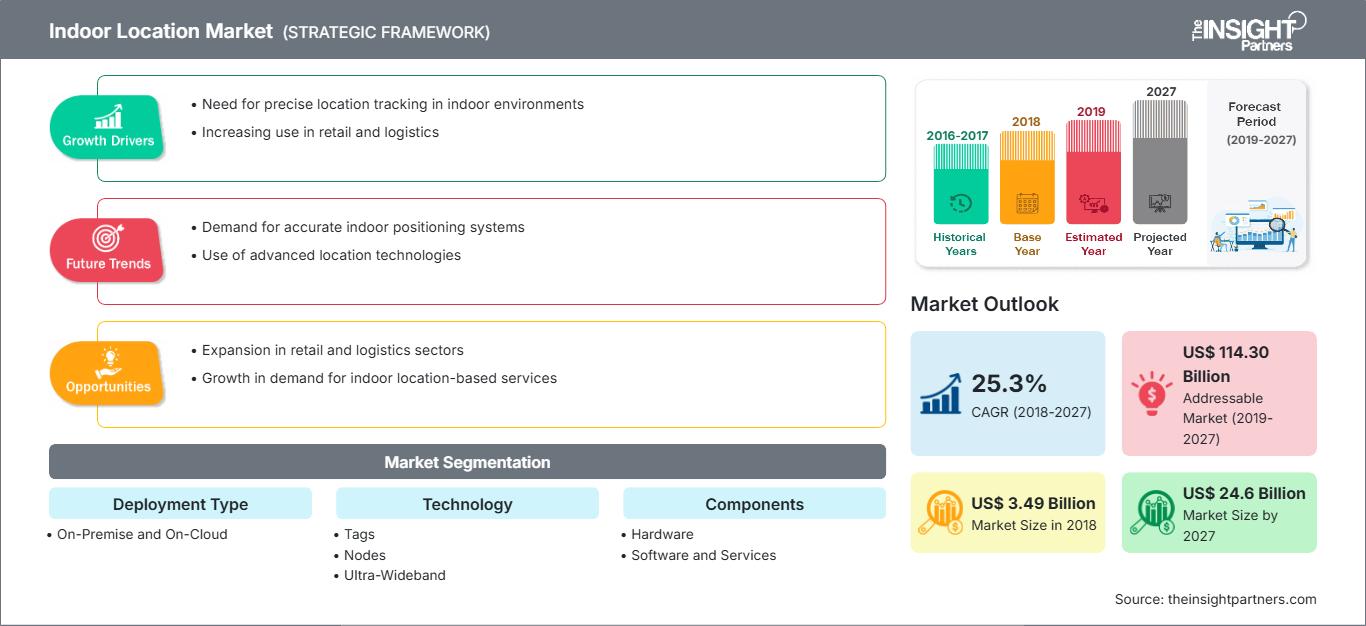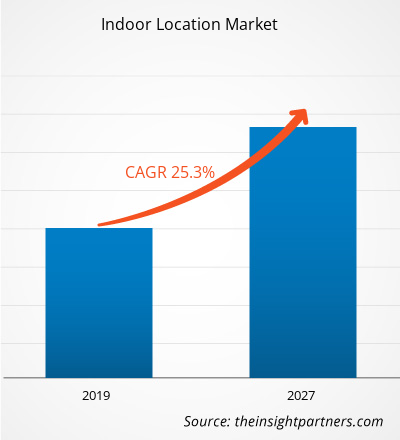The indoor location market was valued at US$ 3,493.8 million in 2018 and is projected to reach US$ 24,601.1 million by 2027; it is expected to grow at a CAGR of 25.3% during 2019–2027.
The availability of positioning technologies has a profound influence over various daily activities and tasks such as navigation, positioning, tracking, monitoring, route optimizing and locating various assets among other applications. Further, the market continues to witness an increase in the scope of application through innovative services and solutions assisting improved level accuracy of positioning technologies. Moreover, the rise in adoption of GPS (Global Positioning System) technologies through an increase in smartphone penetration coupled with the growing popularity of location-based service mobile application has further boosted the demand for superior positioning technologies in the past decade. As a result, the indoor location that leverages the vulnerability of commonly available commercial GPS system in determining efficient position location within an infrastructure. The indoor location-based systems, equipment, and products facilitate assistance in identifying the asset location, tracking, monitoring and proximity among other attributes across a facility with multiple levels. The indoor location solution constitutes sensors and receivers for efficiently identifying asset within a facility. Subsequently, the indoor location has a profound scope of application among various end-users for asset monitoring, inventory management, logistics & transportation, predictive asset management, and sales & marketing optimization among other uses.
The indoor location market has gained substantial traction in the past few years owing to the growing number of connected assets, equipment, machinery, and critical components. Further, the indoor location-based solution and services provide an opportunity to the leading enterprises to leverage their existing IoT infrastructure towards achieving superior operational efficiencies. Among developed economies, the growing emphasis towards superior and exclusive customer experience primarily in the retail sector is gaining significant momentum among countries such as UK, U.S., Germany, and South Korea among other developed economies. Thus, the demand for productive as well as sales & marketing optimization is expected to be the significant market driving force in the coming years. Also, the advancement in technologies has facilitated in development of location technologies capable of delivering superior accurate results with efficient energy utilization. For instance, the ultra-wideband and geomagnetic technologies are projected to provide numerous lucrative, profitable opportunities for the market players in the coming years. Among end-user industries such as manufacturing, retail, utilities, and transportation & logistics among others are expected to witness a surge in demand for various indoor location-based solutions and services in the forecast period.
Customize This Report To Suit Your Requirement
You will get customization on any report - free of charge - including parts of this report, or country-level analysis, Excel Data pack, as well as avail great offers and discounts for start-ups & universities
Indoor Location Market: Strategic Insights

-
Get Top Key Market Trends of this report.This FREE sample will include data analysis, ranging from market trends to estimates and forecasts.
Market Insights–Indoor Location Market
Growing Popularity of Location Enabled Services
The implementation of indoor location system has recently witnessed a significant adoption in diverse verticals ranging from manufacturing to logistics to security to sports. The growth in adoption of indoor location system is attributed to several factors such as widespread availability of low-cost sensors and tags, the sophistication of the sensing and connectivity capabilities in devices that do not impact battery life, and the introduction of open ecosystems that allow organizations to construct more flexible business models without locking them into hardware or software.
Through advancement in positioning technologies the location positioning and navigation capabilities has improved significantly in the past decade. Further, the growing popularity of location-based services especially for smartphones has gained substantial momentum in the past few years. As a result, the leading retailers and luxury retail brands are increasingly focusing on optimizing of marketing strategies towards their loyal customers through adoption of indoor location services for offering more exclusive offers. Subsequently, the retail industry is anticipated to be one of the major market driving forces in the coming years.
Deployment Type Segment Insights
Based on deployment type, the indoor location market is segmented into on-premise and on-cloud. A cloud based indoor location is a web-based software as a service (SaaS) model utilizing enterprise cloud technology. Whereas on premises type system is the one deployed on the native hardware and network of the business. Over the years the on-premises location tracking infrastructure have decreased, while the demand for cloud based system continue to achieve substantial growth rate. This is majorly because the cloud based indoor location offers enhanced flexibility, scalability, disaster recovery, and security to its users. Further it also offers the end-users with the ability to receive automatic software updates without additional capital expenditures, providing better technology competitiveness. Owing to these factors, the cloud based indoor location are expected to receive main market attraction resulting in principle growth rate.
Technology Segment Insights
Based on technology, the indoor location market is bifurcated into tags, nodes, ultra-wideband, bluetooth, wi-fi, visible light communication and radiofrequency identification. Majority of the indoor location systems in the market use a combination of technologies in order accomplish their functions efficiently. Some of these technologies include Wi-Fi, Ultra Wideband, Bluetooth, RFID, and VLC among. Owing to the wide-scale use of multiple technologies, the indoor location networks in the coming years are anticipated to become highly heterogeneous.
Component Segment Insights
Based on component, the indoor location market is bifurcated into hardware, software and services. There is a myriad method in which an indoor location system can be deployed, and a range of technologies that an enterprise can choose from. However, implementation of the indoor system requires a basic of three components that includes the hardware, software and services. The hardware basically comprises of nodes components, networking devices, sensors, receivers and transmitters. The software segment comprises of the APIs that support functioning of the system along with providing analytical insights. Designing and implementation of indoor location requires the managed and professional services, which also contribute to the overall indoor location market revenue.
Application Segment Insights
Based on application, the indoor location market is bifurcated into remote monitoring, customer experience management, inventory management, emergency response management, sales and marketing optimization, risk management, predictive asset analytics and others. The application for indoor location in recent years has witnessed a drastic increase across the globe. These applications vary from customer assistance and marketing to disaster management and recovery, asset management & tracking, security.
Verticals Segment Insights
Based on verticals, the indoor location market is bifurcated into hospitality, retail, transportation & logistics, entertainment, public buildings, manufacturing and others. Understanding customers’ locations indoors is of special importance to retailers, mall owners, the travel and transportation industry (airports, train stations), banks, hospitals, security managers, and any enterprise that provides services to people who are indoors. The need to understand customer behavior in indoor venues is essential for any business aiming to provide a more personal and compelling shopping experience, optimize the physical store layout, improve store operations, and ultimately drive improved user experience, sales conversion rates, and increased revenue.
The market players focus on new product innovations and developments by integrating advanced technologies and features in their products to compete with the competitors.
- 2018: LocusLabs announced strategic partnership with IndoorAtlas with the aim of providing enhanced indoor location-based experiences. The partnership is aimed to develop an end-to-end digital wayfinding solution to power location-based applications and experiences in venues like airport, offices, and railway stations among others.
- 2018: Cisco announced acquisition of July Systems a mobile application platform provider. The acquisition is expected to help Cisco to enhance its enterprise Wi-Fi platform to enable better indoor location services capabilities.
The regional trends and factors influencing the Indoor Location Market throughout the forecast period have been thoroughly explained by the analysts at The Insight Partners. This section also discusses Indoor Location Market segments and geography across North America, Europe, Asia Pacific, Middle East and Africa, and South and Central America.
Indoor Location Market Report Scope
| Report Attribute | Details |
|---|---|
| Market size in 2018 | US$ 3.49 Billion |
| Market Size by 2027 | US$ 24.6 Billion |
| Global CAGR (2018 - 2027) | 25.3% |
| Historical Data | 2016-2017 |
| Forecast period | 2019-2027 |
| Segments Covered |
By Deployment Type
|
| Regions and Countries Covered |
North America
|
| Market leaders and key company profiles |
|
Indoor Location Market Players Density: Understanding Its Impact on Business Dynamics
The Indoor Location Market is growing rapidly, driven by increasing end-user demand due to factors such as evolving consumer preferences, technological advancements, and greater awareness of the product's benefits. As demand rises, businesses are expanding their offerings, innovating to meet consumer needs, and capitalizing on emerging trends, which further fuels market growth.

- Get the Indoor Location Market top key players overview
The Global Indoor Location Market has been Segmented as Follows:
By Deployment Type
- On-premise
- Cloud
By Technology
- Tags
- Nodes
- Ultra-Wideband
- Bluetooth
- Wi-Fi
- Visual Light Communication
- RFID
- Others
By Components
- Hardware
- Software
- Service
By Application
- Remote Monitoring
- Customer Experience Management
- Inventory Management
- Emergency Response Management
- Sales & Marketing Optimization
- Risk Management
- Predictive Asset Analytics
- Others
By Vertical
- Hospitality
- Retail
- Transportation & Logistics
- Entertainment
- Public Buildings
- Manufacturing
- Others
By Geography
-
North America
- U.S.
- Canada
- Mexico
-
Europe
- France
- Germany
- UK
- Spain
- Italy
- Rest of Europe
-
Asia Pacific (APAC)
- Australia
- China
- India
- Japan
- Rest of APAC
-
Middle East & Africa (MEA)
- Saudi Arabia
- South Africa
- UAE
- Rest of MEA
-
South America (SAM)
- Brazil
- Rest of SAM
Company Profiles
- Broadcom, Inc.
- Cisco Systems, Inc.
- Ericsson
- Geomoby
- Indooratlas Ltd
- Micello Inc. (HERE global b.v.)
- Qualcomm Incorporated
- Senion
- STMicroelectronics N.V.
- Zebra Technologies Corporation
- Historical Analysis (2 Years), Base Year, Forecast (7 Years) with CAGR
- PEST and SWOT Analysis
- Market Size Value / Volume - Global, Regional, Country
- Industry and Competitive Landscape
- Excel Dataset
Recent Reports
Testimonials
Reason to Buy
- Informed Decision-Making
- Understanding Market Dynamics
- Competitive Analysis
- Identifying Emerging Markets
- Customer Insights
- Market Forecasts
- Risk Mitigation
- Boosting Operational Efficiency
- Strategic Planning
- Investment Justification
- Tracking Industry Innovations
- Aligning with Regulatory Trends





















 Get Free Sample For
Get Free Sample For